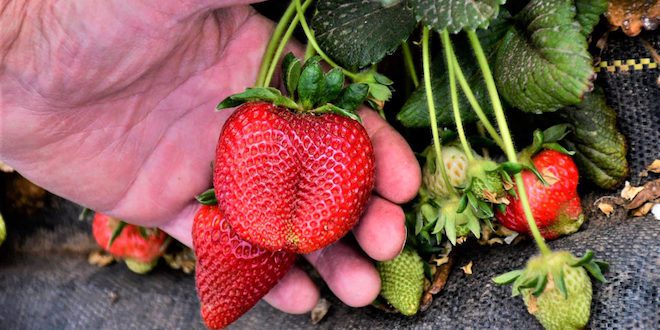

May 6, 2022Texas strawberry season average amid up and down weather
Texas strawberry producers have experienced an average season so far despite freezes, drought and temperature variability impacting yields, according to a Texas A&M AgriLife Extension Service expert.
The growing season started in October with planting, said Russ Wallace, Ph.D., AgriLife Extension horticulturist in Lubbock and professor in Texas A&M’s Department of Horticultural Sciences. Strawberry crowns and root systems develop over winter, and cold temperatures help the plant prepare for fruit production in the spring.
Growth is good around much of the state, but up and down temperatures impacted early season production opportunities, he said. Above-average winter temperatures pushed strawberry plants in East, North and Central Texas to flower early, but a cold front with freezing temperatures knocked off blooms and set plants back.
Last year, Winter Storm Uri also “dinged” strawberry plants, but they recovered and performed well overall, Wallace said.
Fluctuating temperatures somewhat confused the plants this season, he said. Strawberries are a cool-season crop, and while freezing temperatures can hurt blooms and fruit sets, summer-type temperatures can signal the plant to shut down.
Plants typically do well with day temperatures into the low 80 degrees and cooler nights, Wallace said.
Poteet, which is known for its strawberry production, experienced multiple freezes that hurt production, but the area also experienced 100-degree daytime temperatures a few weeks ago, Wallace said.
“Strawberries are very tolerant of cold temperatures, though freezes hurt fruit sets,” he said. “Warmer temperatures signal the plants the end is near. So, if you lose a fruit set or two early to freeze and the plants shut down sooner than they should, it can reduce your production window by several weeks.”
Roller-coaster growing conditions for Texas strawberries
Drought was another factor for strawberry production, Wallace said. Most commercial production acres are irrigated, but meeting plant and fruit daily water-demands at critical stages can influence fruit quality.
“I saw photos of plants around the state earlier this year, and they looked really good,” he said. “After the freeze they reset flowers and were loaded. At that point, if you don’t keep up with the irrigation demand, the strawberries will not fill out properly.”
But too much water can also hurt fruit, Wallace said. Too much water can dilute the brix counts, which is the sugar content measurement in fruits like strawberries and watermelons. Typically, a 9-10 brix count are good for strawberries.
Severe drought can negatively impact strawberries, but drier weather can also help producers by reducing pest and disease pressure, Wallace said. Rainfall and humidity can fuel fungus and mold outbreaks in strawberries, which can be devastating for the crop.
Some strawberry varieties have performed below average this year, Wallace said.
The variety Albion has not performed very well at the Texas A&M AgriLife Research trial plots in Lubbock, Wallace said. He also heard several producers comment about the lack of production by that variety.
Wallace questioned if it could be the fluctuating temperatures, drought or a combination of conditions that led to the subpar performance.
“We don’t really know what happened with that variety this year,” he said. “They’re a day-neutral variety, and so they flower more slowly, and in our area, it can get too hot for them compared to the June-bearing varieties.”
Consumers want local strawberries
Texas strawberry production makes up a small percentage of the nation’s yield. Texas has around 400 acres compared to top-ranked California’s 38,000 acres, Wallace said. Most commercial producers grow anywhere from 1-12 acres and the largest strawberry operation is around 20 acres.
Producers usually grow about 14,000 plants per acre and yields of 1.25 pounds per plant, or 17,500 pounds, are good for growers, he said. Despite the small acreage, the crop has become a lucrative direct-to-consumer product.
Wallace said locally grown strawberries sold at farmers markets or at pick-your-own farms are in high demand throughout the season. They are typically much preferred over strawberries from other states because shipped strawberries are harvested somewhat early to reach grocers in marketable condition.
This season, Wallace has seen prices ranging from $32 for 12 pints, or a flat of strawberries, which is around 8-10 pounds, to $7 per pint at farmers markets, or around three-fourths of a pound of the fruit.
“Consumers are starting to see the difference in locally grown produce, and strawberries are one of those that consumers really want because the taste is so much better,” he said. “There’s just really no comparison.”
Click here to see regional summaries compiled by AgriLife Extension district reporters.














